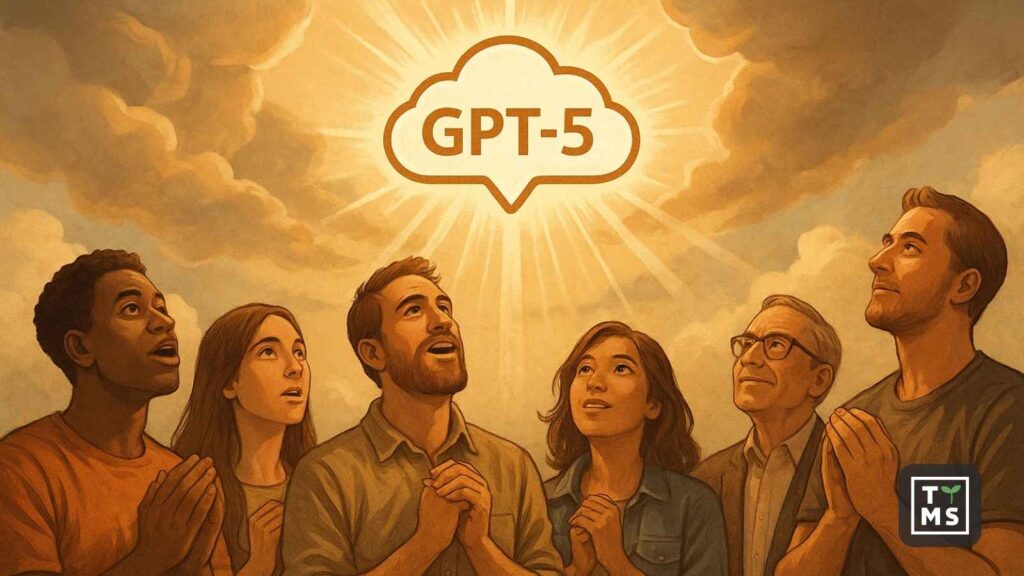What’s New in ChatGPT – July 2025
The latest updates from OpenAI, competitors, and the AI market. What does it mean for your business?
July 2025 brought a wave of key developments in the world of generative AI. ChatGPT is expanding beyond a chatbot: we’ve seen previews of GPT‑5, an AI-powered browser, shopping capabilities, and educational tools. At the same time, competitors like Anthropic, Google, and Meta are accelerating their own innovations.
Here’s a full breakdown of what’s new in AI – and what your company should do about it.
1. When is GPT‑5 launching and how will it change the way we use AI?
OpenAI has officially announced that GPT‑5 is expected to launch in summer 2025. But this isn’t just another model release — it’s the beginning of what OpenAI calls “unified intelligence”: a system that blends text, voice, document analysis, image understanding, and real-time internet access.

What’s new:
- native integration with Canvas (interactive workspaces),
- deeper contextual memory and personalization,
- early agent capabilities (task automation),
- multimodal interaction (voice, images, documents).
Business impact:
GPT‑5 will serve as more than a chatbot — think of it as a multi-role AI assistant: analyst, editor, researcher, customer agent. Businesses should prepare by:
- exploring use cases for internal AI agents,
- testing GPT‑based automation in content, sales or customer support,
- training teams to interact with multimodal AI tools.
2. What is ChatGPT‑Browser and why does it matter to companies?
OpenAI is developing a dedicated AI-powered web browser, based on Chromium, with a ChatGPT interface at its core. It allows AI agents to:
- navigate websites,
- fill out forms,
- perform tasks on behalf of users.
Why it matters:
This marks a shift from “search and browse” to “delegate and execute”. Instead of looking for answers, users can ask AI to act.
For businesses:
- content must now be optimized not only for humans or Google SEO, but also for AI agents parsing and interacting with pages,
- websites and web apps should be compatible with AI navigation (clear structure, predictable flows),
- customer journeys may shift – from browsers to AI agents making decisions on users’ behalf.

3. Will shopping inside ChatGPT disrupt e-commerce as we know it?
OpenAI is testing a built-in shopping and checkout experience in partnership with Shopify. This allows users to:
- discover products through AI recommendations,
- complete purchases directly inside the ChatGPT interface.
Business relevance:
- AI may become a standalone sales channel – outside traditional online stores,
- product data must be structured and integrated into AI-accessible platforms,
- dynamic, personalized product suggestions driven by LLMs may outperform traditional recommendation engines.
4. Why did ChatGPT suffer a global outage in July – and what does it mean for reliability?
On July 16, a major OpenAI outage affected ChatGPT, Sora, and Codex across Europe, Asia, and North America. It was the second such event within a month.
Causes:
- infrastructure stress during internal testing and growing user demand,
- scaling challenges tied to new features (voice, Canvas, API traffic).
What to do:
- businesses using OpenAI services should implement redundant AI providers (Claude, Gemini),
- build failover mechanisms into AI integrations,
- monitor service-level dependencies more proactively.

5. What is the “Study Together” mode – and can it support corporate learning?
OpenAI is testing a new learning experience called “Study Together”, which allows users to:
- interact with structured study sessions,
- ask contextual questions,
- test knowledge through quizzes and summaries.
Use cases for business:
- onboarding new employees with AI-guided sessions,
- upskilling sales, marketing, and support teams,
- using AI as an always-available tutor or coach.
6. How does “Record Mode” turn ChatGPT into a meeting assistant?
The macOS version of ChatGPT Plus now includes Record Mode, allowing users to:
- record live voice conversations or meetings,
- automatically transcribe discussions,
- generate summaries inside Canvas.
Business use cases:
- customer-facing teams can save time on CRM entries,
- consultants and executives can automate meeting notes,
- project teams gain fast access to decisions and follow-ups.
7. How are OpenAI’s competitors evolving – and who’s ahead in July 2025?
Claude 3.5 by Anthropic:
- faster than GPT‑4 in many tasks,
- excels in processing long documents,
- emphasizes safety and refusal handling.
Claude 3.5 is gaining traction in regulated sectors (finance, legal, public).
Gemini 2.5 by Google:
- deeply integrated with Google Workspace,
- multitasking across Docs, Sheets, Gmail and code editors,
- context-aware assistance across Android devices.
Gemini is positioned as the productivity-first AI, leveraging Google’s ecosystem.
Meta AI:
- embedded in WhatsApp, Instagram, and Messenger,
- handles real-time translations, content generation, user queries,
- supports customer-brand interactions inside social apps.
Businesses in B2C and D2C sectors should prepare for AI-first engagement via messaging platforms.
8. How should companies prepare for the next wave of generative AI?
TTMS Recommendations:
✅ Diversify your AI stack – don’t rely on one model.
✅ Experiment with GPT agents and workflows now.
✅ Integrate AI into your workspace (Google, Microsoft, CRM).
✅ Train your team on AI collaboration, not just prompt writing.
✅ Monitor developments in AI agents – they’ll soon impact customer service, order processing and reporting.
Final Thoughts: What to watch in August and beyond?
- GPT‑5 rollout and its potential impact on Microsoft Copilot tools.
- ChatGPT Browser launch and early use cases of agent-based internet navigation.
- Real e-commerce integrations with GPT – will Polish or EU retailers join in?
- Shifting preferences between GPT, Claude, and Gemini in enterprise adoption.
- Meta’s AI expansion in customer messaging – and how it may disrupt traditional chat systems.
Need help preparing your business for AI-powered transformation?
TTMS experts can help you explore the right tools, design pilots, and train your teams.
Is it worth preparing my company for GPT‑5 even before it officially launches?
Absolutely. Preparing your team and infrastructure for GPT‑5 now can give you a significant head start. While GPT‑5 is not yet publicly available, understanding how current models like GPT‑4 work in business contexts helps you integrate AI gradually. Early adoption strategies—such as workflow automation or content support—will make the transition to GPT‑5 faster, smoother, and more effective.
How could AI-powered web browsers change the way customers interact with businesses online?
AI browsers won’t just display content—they’ll interact with it. These agents can read web pages, submit forms, and even complete transactions without human intervention. That means your website needs to be both user-friendly and AI-compatible. Structured data, accessible layouts, and clearly defined actions will soon be critical for how AI understands and navigates your site.
Will AI-driven shopping features be limited to big brands and marketplaces?
No. While early tests are happening through large platforms like Shopify, OpenAI’s roadmap includes broader accessibility. That means smaller businesses will eventually be able to integrate products into ChatGPT-based commerce experiences. The key is preparing structured product data and ensuring your content is visible to AI agents—similar to how you’d optimize for search engines or marketplaces today.
What are the risks of relying on a single AI provider like OpenAI?
Putting all your operations in the hands of one AI vendor introduces risks like outages, API limits, pricing shifts, or data policy changes. The July 2025 ChatGPT outage highlighted these vulnerabilities. A growing best practice is to adopt a multi-model approach—combining providers like OpenAI, Anthropic, and Google to ensure continuity, flexibility, and better performance across tasks.
How is AI transforming employee onboarding and training processes?
Modern AI tools are becoming dynamic learning assistants. They don’t just provide information—they guide, assess, and personalize the learning journey. For HR and L&D teams, this means moving from static training modules to interactive sessions powered by AI. It allows for faster onboarding, skill diagnostics, real-time support, and a more engaging experience for new hires and existing staff.